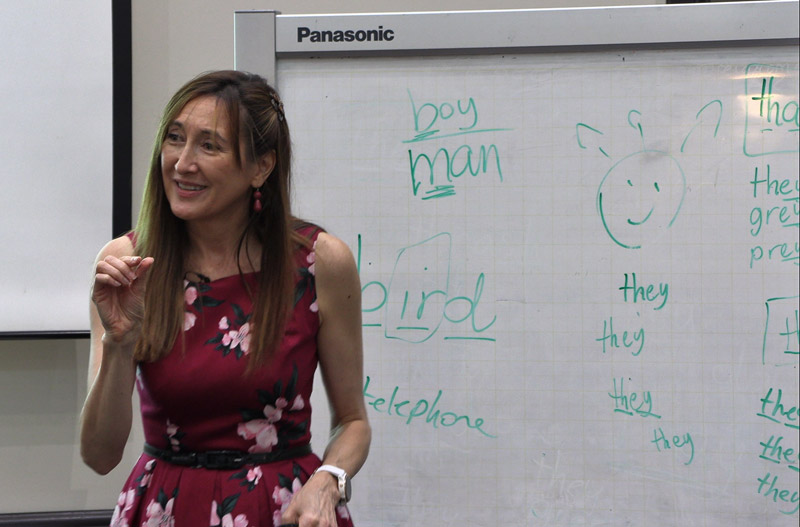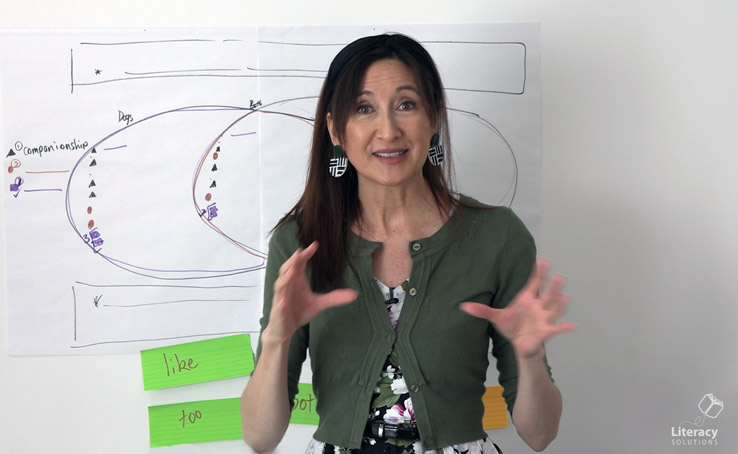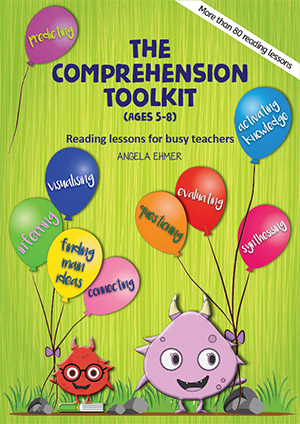Literacy Glossary
A B C D E F G H I J K L M N O P Q R S T U V W X Y Z
- Affixer
- A morpheme added to the beginning or ending of a word. Eg a prefix added to the beginning or a suffix added to the end
- Accent
- The increased stress placed on particular syllables within words. Example: The word ‘photographer’ has the stress on the second syllable. The word ‘photographic’ has the stress on the third syllable.
- Assimilation
- A change to a sound which occurs as a result of a sound following. Example: In the sentence, The recipe has ten parts. The word, ten, can sound like tem, because the n and p are produced using the same lip position.
- Auditory Discrimination
- The ability to discriminate individual sounds in words. Example: Able to discriminate the diff erence between take and tale
- Backchaining
- A technique to help students to pronounce words. Rather than start at the beginning of a word, say the word and then ask the student to say the final syllable or morpheme. Students then work backwards to the whole word, which makes natural stress easier. Backchaining can also be used on whole
sentences. Example: pho/to/graph graph/to/pho When backchaining, model first to emphasise the increased stress on the target syllable. Support students to repeat using guided practice.
- Base word
- A whole word or most of a word that may have affixes added.
- Blend
- More that one phoneme
- Buddy Reading
- occurs when students are paired across year levels (experienced, older reader with younger, less experienced reader)
- Decoding
- Code breaking
- Demand Writing
- occurs when students are engaged in (initially brief) timed writing tasks on a variety of topics and across a range of text types over time
- Digraphs
- Two consonants which create one sound. Example: ch, gh, sh, th, wh
- Disyllabic
- A word with two syllables. Example: in/to doc/tor
- Etymological knowledge
- Knowledge of word histories and origins.
- Guided Reading
-
- occurs when a teacher differentiates reading instruction to suit the needs of learners
- enables a teacher to select a text which matches the specific needs of a small group of students
- enables a teacher to support the small group of students to apply problem solving actions in order to solve the text
- provides opportunities for all students to independently problem solve the text
- provides opportunities for a teacher to revisit the text for particular teaching purposes and monitor student progress
- Guided Reading/Reciprocal Teaching
- occurs when a small group of students work cooperatively to independently problem solve an instructional level text
- supports students using the framework
- predicting
- reading
- clarifying
- questioning
- summarising
- Guided Writing
-
- occurs when a teacher differentiates writing instruction to suit the needs of learners
- enables a teacher to work with a small group of students with a common writing need, providing support and scaffolding as required by the group
- provides students with the opportunity to learn writing skills in context and by constructing and recording their own texts
- Independent Reading
-
- is not an instructional approach
- occurs when students independently read easy or familiar texts
- enables students to build stamina and apply problem solving actions with greater efficiency and accuracy
- Independent Writing
-
- is not an instructional approach
- occurs when students independently construct and record texts
- enables students to develop writing stamina and apply writing skills with greater speed and accuracy
- Individual Reading (reading by students):
- occurs when an expert reader provides strategic support as an individual student independently problem solves an instructional level text
- provides opportunities for the student to apply strategies taught during supported reading sessions or prior individual reading sessions
- Interactive Writing
-
- occurs when an expert writer jointly constructs a text with a small group of less experienced writers with a common writing need/s
- the adult and students work together, taking turns to record aspects of the shared text (on a whiteboard, blackboard, butchers' paper or IWB)
- the expert prompts less experienced writers to recall and apply writing knowledge to record the text
- Iteration
- Quick, brief repetitions of a sound. Example: p-p-p-pot
- Language Experience
-
- is a brief, focused oral language mini-lesson around a central theme or idea (shared experience such as an excursion/sports day, a stimulus picture or item, book, etc.)
- the experienced language user uses the shared experience to build vocabulary, language and text structures, topic knowledge, general knowledge, speaking and listening skills
- Literature Circles
-
- a small group collaborative approach which supports and scaffolds students to apply comprehension strategies to longer (usually narrative) texts
- enables students to work together in small, mixed ability discussion groups focused around the reading of a text or section of a text
- provides supports for students in the form of "role cards" which prompt students within groups to take on particular roles for the discussion (e.g. summariser, connector, predictor, etc.)
- Modelled Reading
- occurs when an expert reader reads a difficult text to less experienced readers, enabling the experienced reader to model how effective readers sound, solve and think about texts when reading
- The "think aloud" strategy is used strategically by the expert reader to model the thinking and problem solving undertaken.
- Minimal Pairs (or Close Pairs)
- Words with sounds which are similar. Example: ship, sheep
- Modelled Writing
-
- occurs when an expert writer demonstrates the crafting and recording of a text, enabling the experienced writer to model how effective writers formulate ideas, translate ideas to text, construct sentences, apply vocabulary, spelling, punctuation and text type knowledge
- The "think aloud" strategy is used strategically by the expert writer to highlight the thinking and problem solving actions undertaken.
- Monosyllabic
- A word with one syllable. Example: car, hat
- Morpheme
- The smallest unit of language that carries meaning
- Non-Rhotic speakers
- Individuals who do not pronounce the /r/ sound after vowels, but do pronounce it
before a vowel. Example: /r/ is not pronounced: harm, world /r/ is pronounced: rat, rest
- Onomatopoeia
- A word that sounds like the sound it represents. Example: splash, BANG
- Onset
- Letter/letters preceding a rime. Example: /d/ /og/, /d/ is the onset, /og is the rime
- Orthography
- The way letters or letter configurations are assembled to represent words. Example: /d/ /o/ /g/, /b/ /ike/
- Pedagogy
- This term generally refers to strategies of instruction, or a style of instruction. It is sometimes referred to as the correct use of teaching strategies
- Peer Reading
- occurs when students are paired with a member of their own cohort (same or similar age)
- Phoneme
- A single unit of sound within a word. Example: /a/, /b/, /ch/
- Phonemic awareness
- The awareness of sounds within a language, and the understanding of the relationship of these sounds. Example: words in sentences, syllables, rhyming
- Phonemic identity
- Speech sound and placement within a word or sound pattern. Example: “Which word has the /s/ sound*, soon, moon. Where can you hear the sound? Is it at the beginning, in the middle or at the end?“ Repeat the words slowly. *The teaching focus is the sound, so the sound for /s/ is made rather than giving the letter name.
- Polysyllabic
- A word with three or more syllables. Example: exciting, wonderful
- Prosity
- Pitch, tone, intonation and volume
- Reading Aloud
- occurs when an expert reader reads a difficult text to less experienced readers for the purposes of:
- building a community of readers,
- creating shared experiences amongst students,
- exposing students to new ideas, story lines, characters and contexts,
- exposing students to new vocabulary, text and language structures,
- building a love of reading.
- Rhotic speakers
- Rhotic speakers pronounce the sound of the letter r after vowels in all positions. Example: cart, world
- Rhyme
- Shared sound pattern at the end of words. Example: pond, wand; cat, mat
- Rime
- Shared sound pattern that also shares a spelling pattern. Example: cat, mat
- Shared Reading
-
- occurs when an expert reader reads a difficult text and students follow the words with their eyes
- provides opportunities for the experienced reader to explicitly teach or demonstrate a strategy or strategic action
- enables the teacher to use the same text for multiple teaching purposes
- provides opportunities for students to join in with the expert reader to read a hard level text
- involves reading to, with and by students
- Shared/Joint Construction
-
- occurs when an expert writer jointly constructs a text with a group of less experienced writers
- the expert records the text which is a collaboration of ideas
- the expert prompts less experienced writers to recall and apply writing knowledge
- Stop sound
- Speech sounds that end the flow of air after articulation. Example: /b/, /d/, /g/, /h/, /j/, /k/, /p/, /q/, /t/, /w/, /x/, /y/
- Stretch sound
- Speech sounds that have an uninterrupted flow of sound when articulated slowly. Example: /a/, /e/, /f/, /i/, /l/, /m/, /n/, /o/, /r/, /s/, /u/, /v/, /z/
- Syllable
- A clearly uttered unit of sound containing a vowel sound (a,e,i,o,u,y) and usually a consonant/s. Example: in/to, a/way, yes/ter/day
- Unvoiced sound
- A speech sound originating in the mouth. Example: /p/ /t/ /k/ /s/ /h/
- Voiced sound
- A speech sound that can be felt in the throat as vocal cords vibrate. Example: /a/, /e/, /i/, /o/, /u/, /b/ /d/ /g/ /v/




